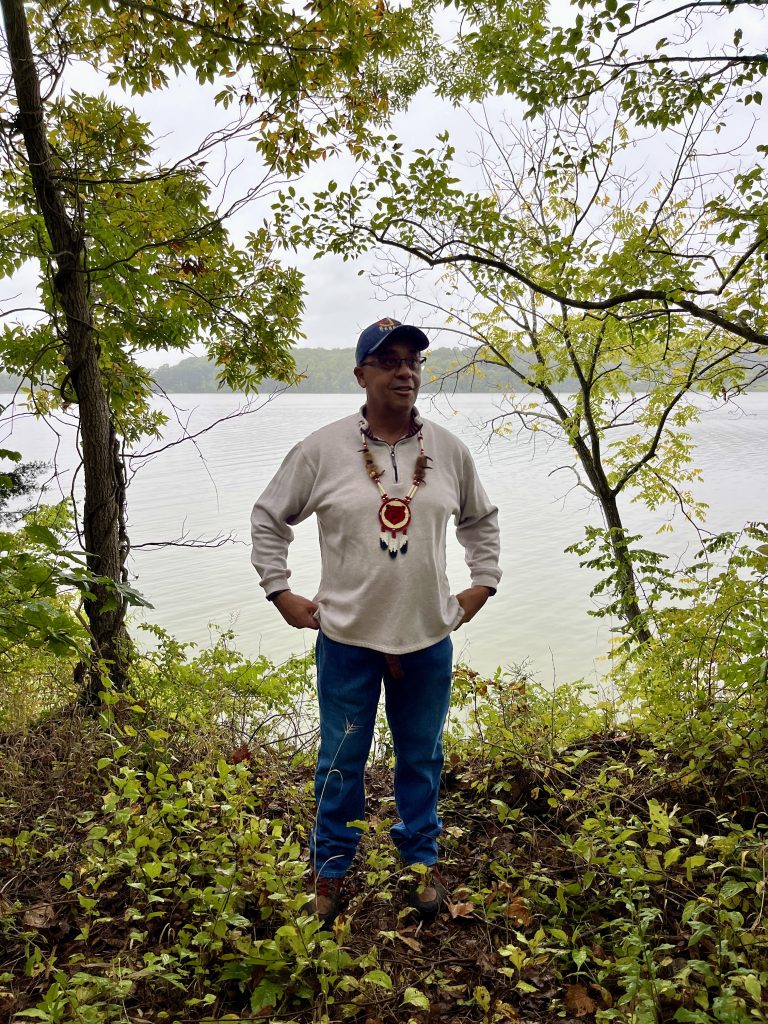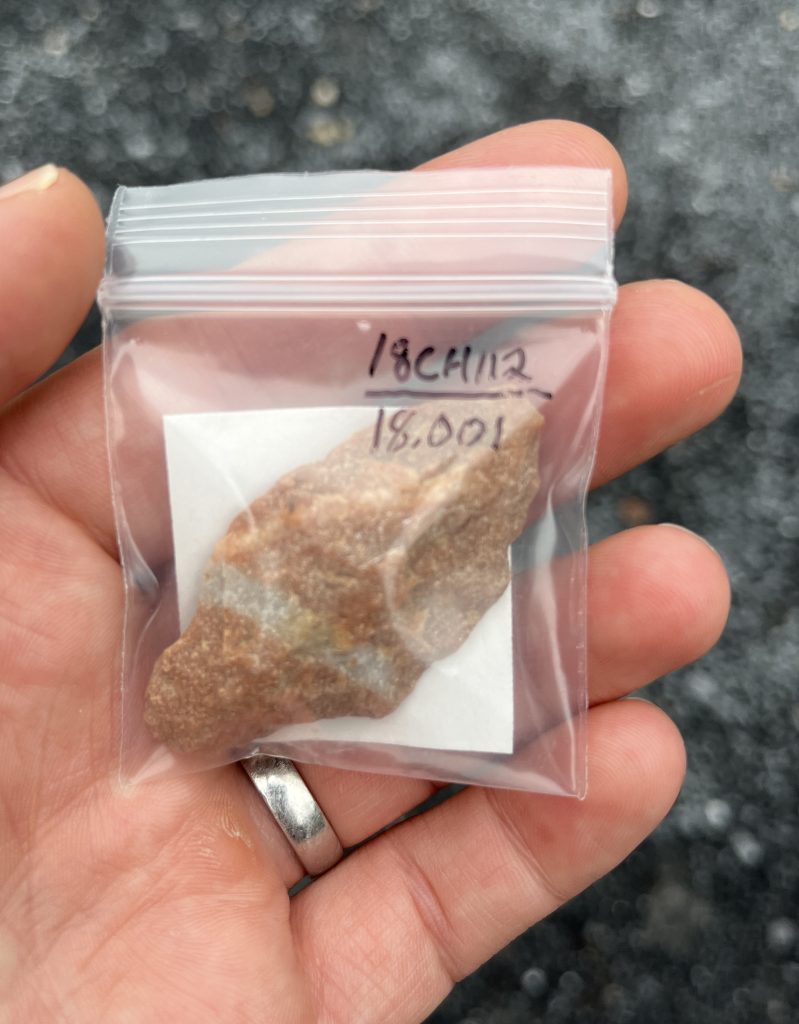
Francis Gray, the tribal chairman of today’s Piscataway Conoy Tribe, stands near the dig site at Chapel Point State Park on the banks of the Port Tobacco River. Credit: A.J. Metcalf/ Maryland DNR
Before John Smith arrived and even before the glaciers melted to create the Chesapeake Bay, Indigenous Peoples had called the land that is now Maryland home.
Indigenous sites in Maryland have been dated as early as 12,000 years ago by archaeologists. Many Indigenous People lived along the then Susquehanna River, using the resources provided by the land.
As the Susquehanna’s channel widened and the Chesapeake Bay began to form about 10,000 years ago, a majority of these settlements were inundated by water. The people who lived there moved, often following food resources such as oysters and fish.
“The Chesapeake Bay has long been a vital resource for people including Native Americans, especially as the Bay began to form,” said Julia A. King, professor of Anthropology at St. Mary’s College of Maryland. “It provides all sorts of seafood. The rising waters created marshlands that sort of acted as a refrigerator by providing animals and plant species that people could use. A lot of native settlements were located near riverine environments and marsh.”
Thanks to state and federal grants, a growing relationship with today’s Piscataway descendants, and a strong partnership with Maryland’s Department of Natural Resources, King has been working with her students and colleague Travis Hanson, an archaeologist, to uncover the history of Indigenous Peoples in Southern Maryland.
On a cloudy fall day earlier this year, Hanson joined Park Rangers and others at Chapel Point State Park to detail their ongoing work in the park as part of the Department of Natural Resources’ annual Science Week. In pre-colonial times this area was home to the Potobacs, who were part of the Piscataway Chiefdom, which had emerged on the shores of the Potomac River around 1200 AD.
Hanson guided the small group through a narrow trail at Chapel Point State Park to an area next to a natural spring where paw paw trees were growing. The area was chosen for exploration due to the concentrations of oyster shell middens–basically dumping areas for discarded oyster shells, which indicate people had been gathering nearby and eating oysters. In 2023, Hanson, King, and others dug several small test pits to search for artifacts and any structural remains.
Evidence indicates there was an extensive Indigenous settlement in the area that likely stretched to the other side of the Potomac.
“We found lots of projectile points (arrowheads), ceramics, and stone tools,” said King. “We only scratched the surface and found hundreds of artifacts.”
Through her work, King has developed a collaborative relationship with contemporary Piscataway descendants including Francis Gray, the tribal chairman of today’s Piscataway Conoy Tribe, one of three state-recognized tribes in Maryland. Gray joined the group that had gathered at Chapel Point.
“We’ve come to understand that by having conversations with archaeologists and researchers we can help each other out,” Gray said. He noted that through their collaborative work they’ve been able to confirm Native American community locations and find ways to protect those sites.
“It’s important for researchers and others to understand that they’re finding artifacts that belonged to a people who still exist,” Gray said. “This whole river here was not one small concentrated community. Like the Nanticoke, Choptank, and Wicomico, these were all metropolises before colonization, people lived on both sides of the Potomac River.”
King hopes that through further research the team can discover the location of the Jesuit mission where Father Andrew White operated. White led the first Catholic Mass in the English-speaking colonies after Maryland colonists first arrived in the new colony in 1634. His parish was set up around 1641 in Chapel Point, although the exact location is unknown. Finding the parish may help inform the history of how early colonists interacted with the Piscataway and other tribes in the area.
What is known–the arrival of the colonists caused feuds among the Piscataway, who had previously been attacked by colonists from Jamestown. Records uncovered from that time suggest that the Piscataway Tayac Kittamaquund–the tribe’s chief–killed his brother to take power in an effort to normalize relations with the arriving colonists. Kittamaquund’s older brother–Wannas–had mistrusted the English.
Despite some initial normalizing of relations, the English colonists expanded their reach and took over the land once foraged and farmed by the Piscataway and other Indigenous Peoples, during the next several decades.
Gray hopes that the history of the Piscataway can be more accurately told and preserved through respectful archaeology, signage in state parks, and interpretive education about Indigenous Peoples throughout Maryland.
“This is just woods to most people, they don’t see the history,” Gray said, as he stood in the middle of the former dig site at Chapel Point State Park.
At the Department of Natural Resources, staff are working with Gray, King, and Hanson to better tell the story of the Piscataway. During the fall event, the Department’s Environmental Justice Officer, Mariah Davis, discussed opportunities with Gray and park staff to create interpretive programs–written in coordination with the tribal community–to educate visitors about the rich Indigenous heritage in Southern Maryland at the park. Davis and Gray also discussed opportunities to collaborate with the Piscatoway Canoy Tribe to grow culturally important crops and plant species on park land.
Gray welcomed the idea and suggested that a red cedar be planted in a prominent position at Chapel Point.
The red cedar tree is a sacred plant for the Piscataway people. They consider the evergreen as full of life and believe its red center core represents the life-blood of all animals, including man.
“We don’t want the footprint of our people to be erased,” Gray said.
By A.J. Metcalf, communications director with the Maryland Department of Natural Resources.


